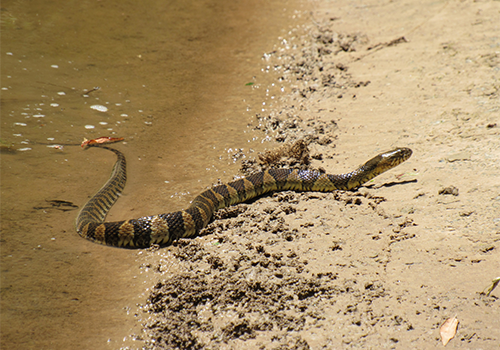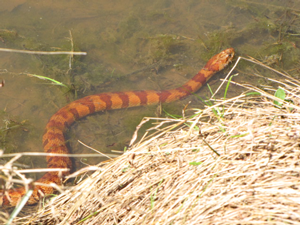Snakes Alive, Mercy Me! How Do You ID Them?
Snakes Alive, Mercy Me! How Do You ID Them?
By Bill Willis and Jeff Church
April 2018

(Photo courtesy of Bill Willis)
- Snakes emerge during period of warm weather to sun and mate.
- Snakes prefer to avoid humans and will slither away if allowed the opportunity.
- Learn to identify the copperhead and the water snakes to avoid a bad interaction.
As the weather fluctuates between warm and cool, our reptiles and amphibian will use the warmth to emerge from their winter hiding places. Turtles are filling up the logs and banks of Discovery Lake. It's during warm days that humans and snakes want to get outside. The two are destined to see each other, but that shouldn't be problematic if the snakes aren't disturbed.
Snakes are good to have in the environment and seeing one may be indicative of a balanced environment. Snakes provide a service in keeping the rodent, reptile, and insect populations in check. In addition, snakes provide a food source for mammals, birds, or even fish.

(Photo courtesy of Bill Willis)
When walking outside, please keep these points in mind:
- Chances of seeing a snake are small but not zero
- Most snakes are non-venomous and not aggressive but will respond to threats, so avoid them if possible. Allow them to get out of your way
- Look where you step or put your hands
- Don't handle an injured or dead snake. A reflex reaction may still get you bitten
- Use the sight of a snake as a positive teaching tool. Use a guide to help identify
- Report a possibly venomous snake sighting to Security at 919-541-7515
It is wise to keep a safe distance from any snake. There are characteristics (18MB) of the body and head that will help distinguish the copperhead from the water snake, besides the water snake being in or near water. The water snake has round pupils and narrow head (not triangular).
Don't fall victim to a case of mistaken identity. Check the links in this article to help you make the right call while in the woods or near the lake.



